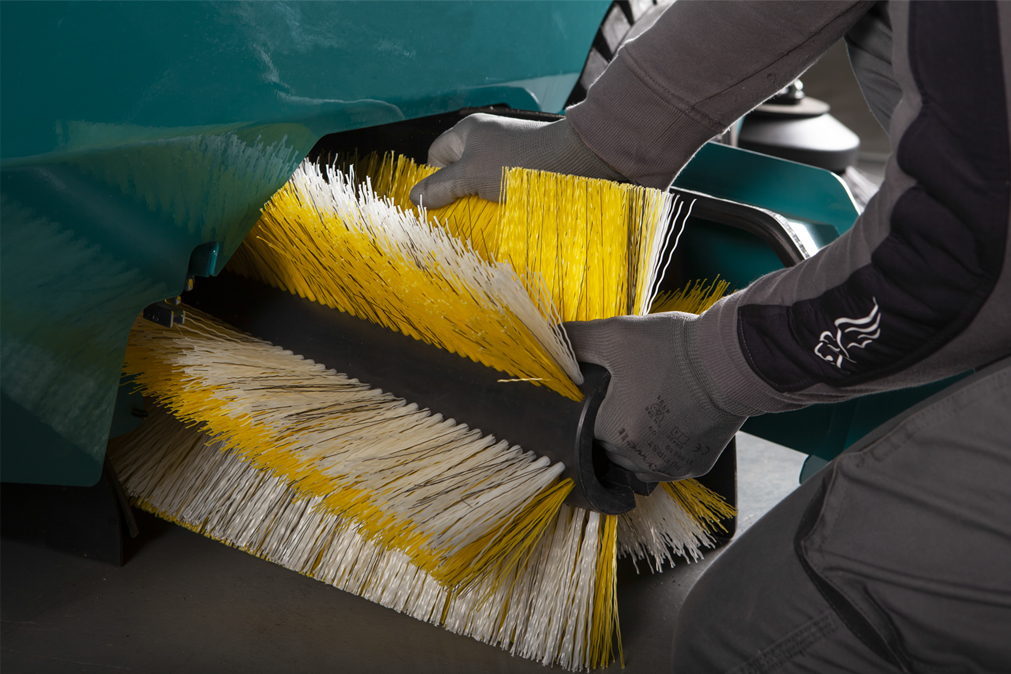
Brushes for sweepers: types, maintenance and tips for perfect cleaning
Learn all about sweeper brushes: types, maintenance and advantages. Find the perfect brushes for your professional sweeper with MP-HT.
Read the articleHow to clean a floor? No matter how often you clean your floors, you need to sweep to get good results before mopping. The sweeper is the tool that allows you to mechanically, precisely and quickly remove non-adherent dirt, such as small solid debris and dust, from different types of surfaces, both industrial and civil, preparing the area for the next phase of washing.
Sweepers, whose main function is sweeping, are used both in the private sector - in production industries, warehouses, shopping malls, accommodation facilities - and in the urban sector, supporting towns and municipalities in the care and cleaning of squares, streets, pavements and all public spaces.
Getting a simple and agile professional sweeper, capable of cleaning quickly and effectively, is the only way to keep a constantly clean and healthy environment, avoiding extremely expensive damage to the machinery of the production lines caused by the deposit of dust and dirt over time.
To understand how a sweeper works, it is important to know the main components that make it up, such as:
The common purpose of any sweeper is to sweep and collect non-adherent dirt. In the market, these machines differ according to several characteristics, including the type of power supply, the type of traction and the type of load. Let’s look at them in detail.
Motorised sweepers. Motorised sweepers can be powered by internal combustion engines, running on petrol, diesel or LPG. They are high-performance machines and are preferred for cleaning outdoor environments. The hybrid version, like the AGILE MAX 108 and AGILE MAX 109 sweepers, uses a technology that combines the petrol engine with an electric unit connected to a battery pack, ensuring a reduction in consumption and greater working runtime.
Battery-powered sweepers. These electric sweepers can install different types of batteries: lead-acid, AGM/gel or Lithium-Ion. Silent and ecological, they are ideal for cleaning indoor environments, but also in outdoor spaces such as urban centres, ensuring a significant reduction in CO2 emissions.
Depending on the type of traction, the following are distinguished:
Walk-behind sweepers. Handy and compact, they are designed for daily cleaning of small and medium-sized environments, both indoor and outdoor. Small in size, the traction is managed directly by the operator, who pushes it forward as he walks. All MP-HT sweepers are equipped with mechanical traction, so that operation does not require any effort on the part of the operator.
Ride-on sweepers. Suitable for working on medium-sized and large surfaces, such as logistics centres, industries but also streets and squares, they are characterised by a wide cleaning track and a greater filtration capacity. These machines are equipped with an on-board station and the operator steers them via steering and controls.
There are different types of ride-on sweepers on the market, which are also distinguished by the type of load: In front-loading sweepers, the central brush moves the dirt forward - “broom/dustpan principle” - into the waste container located at the front of the sweeper. These machines, usually large, are suitable for collecting heavy dirt in typical heavy industry environments.
In rear-loading sweepers, the central brush “throws” the dirt backwards, towards the waste container located on the rear of the sweeper. These agile and easily manoeuvrable machines are capable of collecting even bulky light waste, perfectly adapting to the cleaning of commercial areas or light industrial spaces.
Whether walk-behind or ride-on, the sweeper does not require specific training and certification to be able to use it, as can be required by other work machines such as forklifts. Only if the machine is to be operated on the road, the operator, in compliance with the Highway Code, must be in possession of a drive license and the sweeper itself must be provided with a license plate and registration certificate.
Even if the sweeper is a simple machine and doesn't require a license to use it, there are some recommendations to follow to get good results and avoid unpleasant accidents to people and/or damage to the machinery itself:
Foundries, cement factories, warehouses, shopping malls, car parks, pavements, squares, streets... Cleaning is an activity common to many spaces, both indoor and outdoor, and for each one there is a sweeper that best suits them, capable of responding efficiently to specific cleaning needs.
For over thirty years we have been producing industrial sweepers and urban sweepers capable of making cleaning not an obstacle to be overcome (which hinders work) but a practice capable of adding value to one’s work, useful for saving time and money.
Discover all the benefits of MP-HT sweepers, and how they will help you transform the cleaning task from an expensive hassle into an added value for your company.